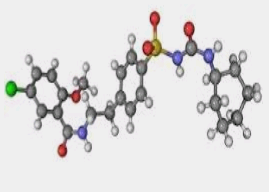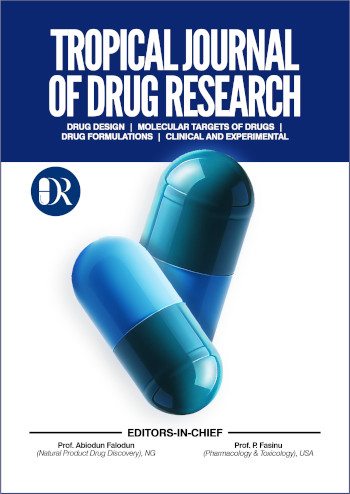Synergistic Antidiabetic Effects of Vernonia amygdalina Leaves and Glibenclamide on Alloxan-Induced Wistar Rats
DOI:
https://doi.org/10.26538/tjdr/v1i1.5Keywords:
glibenclamide, oxidative stress, anti-oxidant, anti-diabetic, Vernonia amygdalinaAbstract
Purpose: One chronic illness that affects millions of people worldwide is diabetes mellitus. If left untreated, it can hasten the body's degenerative processes. Vernonia amygdalina (V. amygdalina) is used as a vegetable and herb, mostly found in tropical Africa. V. amygdalina is one of the many plants with anti-diabetic properties. The study’s objective was to understand the anti-diabetic activity of V. amygdalina leave’s methanol extract and its synergistic effect with glibenclamide on alloxan-induced rats.
Methods: Injection of alloxan monohydrate (160 mg/kg) intraperitoneally (i.p.) led to the induction of diabetes in the Wistar rats. The rats were grouped into five: normal (group 1) and diabetic (group 2) controls, glibenclamide at 2 mg/kg (group 3), 200 and 2 mg/kg of V. amygdalina and glibenclamide (group 4), respectively and methanol extract of V. amygdalina’s 200 mg/kg (group 5). Each treatment was orally. The consequence of V. amygdalina on blood glucose, lipid profile, oxidative stress markers, haematological, and renal function indices was determined by standard methods.
Results: At p < 0.05, V. amygdalina extract significantly reduced the fasting blood glucose concentration in alloxan-induced rats relative to untreated/diabetic rats. Group 4 showed relatively lower concentrations of TCL, LDL, VLDL, and TAG compared to group 5. Higher levels of reduced glutathione and catalase was observed in group 4 relative to group 1 and group 5. Equally, a comparatively higher level of malondialdehyde were observed in group 5 than in group 4. In the haematological profile, the extract-treated groups exhibited relative elevation in RBC count, PCV, and Hb concentration compared to group 2.
Conclusion: The most promising treatment group is group 4 rats treated with extract and glibenclamide. The results demonstrated that sulphonylurea medications like glibenclamide can increase the potential anti-diabetic impact of V. amygdalina leaves.
Downloads
References
1. Maritim, A. C., Sanders, R. A. and Watkins, J. B. Diabetes, oxidative stress, and antioxidants: A review. J. Biochem. Mol. Toxicol. 2003; 17(1):24–38.
2. Loghmani, E. Diabetes Mellitus: Type 1 and Type 2. In: Stang, J., Story, M. (Eds)., Guidelines for Adolescent Nutrition Services; 2005.
3. Kangralkar, V. A., Patil, S. D. and Bandivadekar, R. M. Oxidative stress and diabetes: a review. Int. J. Pharm. Appl. 2010; 1(1): 38–45.
4. Swee, K., Wan, Y., Ho, B., Boo, K. H., Woon, S. L., Huyunh, K., Abdul, H., Naoman, Y. and Noorjaham, B.A. (2010). V. amygdalina: an ethnoveterinary used green vegetables with multiple bioactivities. J Med Plant Res. 2010; 4(25):2787-2812.
5. Agbogidi, O. M. and Akpomorine, M. O. Health and nutritional benefits of bitter leaf (Vernonia amygdalina DEL.). Int J APSBMS. 2013; 2(3): 164-170.
6. Ijeh, I. I. and Ejike, C. E. C. C. Current perspectives on the medicinal potential of Vernonia amygdalina Del. J Med Plant Res. 2011; 5(7): 1051–1061.
7. Oboh F. O. J. and Masodje H. I. Nutritional and antimicrobial properties of Vernonia amygdalina leaves. Int J Biomed Health Sci. 2009; 5(2): 51-57.
8. Izevbigie, E. B., Bryant, J. L. and Walker, A. A novel natural inhibitor of extracellular signal related kinases and human breast cancer cell growth. Experimental Biol. 2004; 229: 163-169.
9. Abosi, A. O. and Rasoreta, B. H. In-vivo anti-malarial activity of V. amygdalina Del. British J Biomed Sci. 2003; 60(2):89-91.
10. Mark, V. and Dawson, A. Rapid stick method for determining blood glucose concentration. British Med J. 1965; 1:25-29.
11. Allain, C.C., Poon, L.S., Chan, C.S.G., Richmond, W. and Fu, P.C. Enzymatic determination of total serum cholesterol. Clin Chem. 1978; 20: 470-475.
12. Albers, J. J., Warmick, G. R. and Cheng, M. C. Determination of high density lipoprotein (HDL) cholesterol. Lipids. 1978; 13:926-932.
13. Friedewald, W. T., Levy R. J. and Fredrickson D. S. Estimating the concentration of low-density lipoprotein cholesterol in plasma, without the use of the preparative ultracentrifuge. Clin Chem. 1972; 18(6): 499-562.
14. Wallin, B., Rosengren, B., Shertzer, H. G. and Cameo, G. Lipoproien oxidation and measurement of thiobarbituric acid reactive substances formation in a single microtitre plate. Its use foe evaluation of antioxidants. Annual Biochem. 1993; 208:10-15.
15. Jollow, D. J., Mitchell, J. R., Zampaglione, N. and Gillete, J. R. Bromobenzene-induced liver necrosis: Protective role of glutathione and evidence for 3, 4-bromobenzene oxide as the hepatotoxic metabolite. Pharmacol. 1974); 11: 151-169.
16. Aebi, H. Catalase In Vitro: Methods of Enzymatic Analysis. Academic Press, New York. 1984; pp. 671-684.
17. Dacie, J. V. and Lewis, S. M. Practical Haematology. 9th Edn. Churchill Livingstone, London. 2000.
18. Fawcett, J. K. and Scott, J. E. Spectrophotometric determination of urea in human serum. J Clin Pathol. 1960; 13: 156-162.
19. Henry, R. J., Cannon, D. C. and Winkleman, J. W. Clinical Chemistry: Principles and Techniques. 2nd Edn. Harper and Row. 1974; p. 525.
20. Bakirel, T., Utku, B., Oya, U. K., Sinem, G. U. and Hasret, Y. In vivo assessment of antidiabetic and antioxidant activities of rosemary (Rosmarinus officinalis) in alloxan–diabetic rabbits. J Ethnopharmacol. 2007; 116: 64-73.
21. Adeneye, A. A., Agbaje, E. O. Pharmacological evaluation of oral hypoglycemic and antidiabetic effects of fresh leaves ethanol extract of Morinda lucida Benth in normal and alloxan-induced diabetic rats. Afr J Biomedl Res. 2008; 11: 65-71.
22. Lenzen, S. The mechanisms of alloxan- and streptozotocin-induced diabetes. Diabetologia. 2008; 51(2): 216–226.
23. Yokozawa, T., Cho, E., Sasaki, J., Satoh, S. Okamoto, A. and Sei Y. The protective role of Chinese prescription Kangen-karyu extract on diet-induced hypercholesterolemia in rats. Biol Pharm Bull. 2009; 29:760–765.
24. Forman, H. J., and Zhang, H. Targeting oxidative stress in disease: promise and limitations of antioxidant therapy. Nat. Rev. Drug Discov. 2021; 20(9): 689–709. doi:10.1038/s41573-021-00233-1
25. Gwarzo, M. Y., Nwachukwu, V. A. and Lateef, A. O. Prevention of alloxan-induced diabetes mellitus in rats by vitamin A dietary supplementation. Asia J. Ann. Sci. 2010; 4:190–196.
26. Akinosun, O. M. and Bolajoko, E. B. Total Antioxidant Status in Type II Diabetic Patients. Nigerian J Clin Practice. 2007; 10(2):126–129.
27. Momoh, J., Odetunde, S. K. and Longe, A. O. Phytochemical analysis, in vitro evaluation of antioxidant and antimicrobial activity of methanolic leaf extract of Vernonia amygdalina (bitter leaf) againstStaphylococcus aureus and Pseudomonas aeruginosa. Int J Curr Microbiol Appl Sci. 2015; 4(5): 411-426.
28. Al-Mamary, M., Al-Meeri, A. and Al-Habori, M. Antioxidant activities and total phenolics of different types of honey. Nutr Res. 2002; 22:1041-1047.
29. Gupta, V. K. and Sharma, S. K. Plants as natural antioxidants. Nat Prod Radiance. 2006; 5:326-334.
30. Gwarzo, M. Y., Ahmadu, J. H., Ahmad, M. B. and Dikko, A. U. (2014). Serum glucose and malondialdehyde levels in alloxan-induced diabetic rats supplemented with methanolic extract of Tacazzea apiculata. Int J Biomed Sci, 10(4): 236–242.
31. Akindele,O. A., Babatunde, A. I., Chinedu, F. M., Samuel, O. A., Oluwasola, C. A. and Oluseyi, A. A. Rat model of food induced non-obese-type 2 diabetes mellitus; comparative pathophysology and histopathology. Int J Physiol, Pathophysiol Pharmacol. 2012; 4(1): 51-58.
32. Colak, S., GeyiKoghu, F., Aslan, A. and Deniz G. Y. Effects of Lichen extracts on haematological parameters of rats with experimental insulin-dependent diabetes mellitus. Toxicol Ind. Health Publishers. (2012).
33. Orhue, E. G., Idu, M., Atamari, J. E. and Ebite, L. E. Haematological and histopathological studies of Jatropha tanjorensis leaves in rabbits. Asian J Biol Sci. 2008; 192: 84-89.
34. Eyo, J. E., Nwachukwu, L. O., Onah, I. E., Atama, C. I., Ekeh, F. N., Ezenwaji, N. E. and Ivoke, N. “Effects of the aqueous root extract of Vernonia amygdalina on the haematological profile of Rattus norvegicus”. Adv Life Sci Technol. 2013; 11:19 – 24.
35. Ejere, V. C., Chukwukezie, C. E., Nnamonu, E. I., Chukwuka, C. O., Echi, P. C., Ugwu, G. C., Odii, E. C. and Ejim, A. O. Effect of Vernonia amygdalina ethanolic extract on the hepato- and nephro-protective properties of albino rats (Rattus novergicus). Adv Life Sci Technol. 2015; 30:34–40.
36. Sood, R. “Medical Laboratory Technology”. Jaypee Brothers Medical Publishers Limited, New Delhi. 2006.
37. Mehrdad, M., Mozhgan, G. P., Sayed, A. T. and Alireza, J. Study of histopathologic changes of Zingiber extract on mice kidneys. Int Conf Food Engr Biotechnol. 2011; 9:16–20.
38. Nwangwu, S. C., Sunday, J. J., Usunomena, U., Nwangwu, U., Akintola, A. A., Ehiremen, O. I. and Omage, K. Effect of aqueous and ethanolic extracts of Vernonia amygdalina leaf on the plasma lipid profile and liver function parameters of normal rats. Curr Res J Biol Sci. 2011; 3(5): 504–508.

Downloads
Published
Issue
Section
License

This work is licensed under a Creative Commons Attribution-NonCommercial-ShareAlike 4.0 International License.




